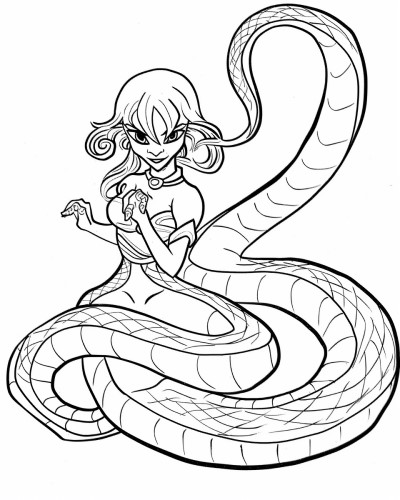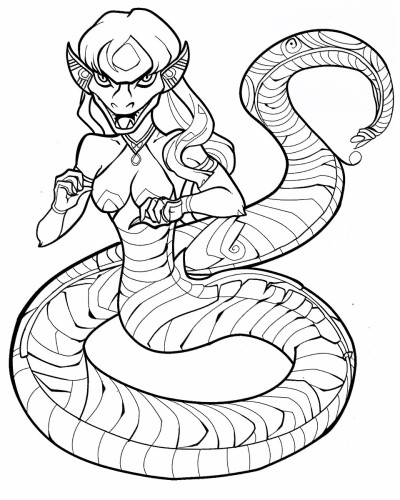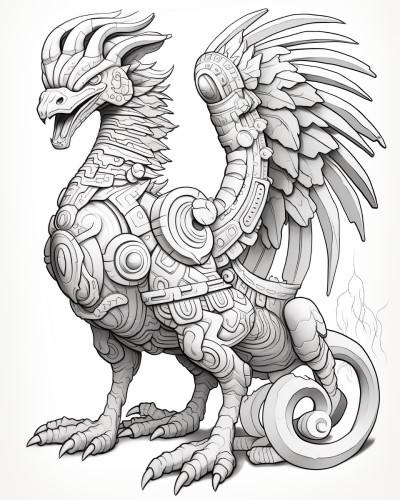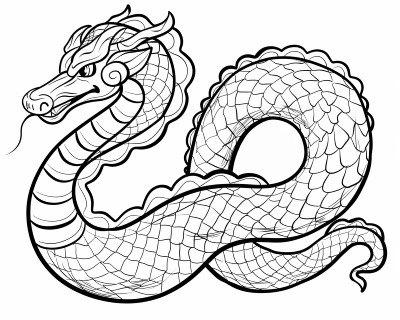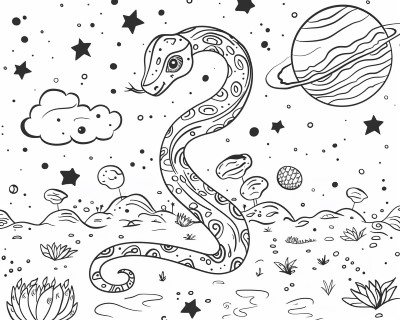Printable Coloring Pages of
Snakes in Stories, Mythology and Legends
Snakes have played symbolic roles in various mythologies, legends, and stories across different cultures, often representing duality in their nature--life and death, healing and poison, rebirth and destruction. Here's a look at how snakes are depicted in various traditions, including Egyptian mythology:
Kaa in "The Jungle Book" by Rudyard Kipling:
- Kaa, the rock python, is one of the most complex characters in "The Jungle Book." While he is sometimes seen as a threat, he also plays the role of a protector and mentor to Mowgli, using his hypnotic powers to save the boy on more than one occasion.
Nagini in the "Harry Potter" series by J.K. Rowling:
- Nagini is a large snake who is closely associated with Lord Voldemort, serving as one of his Horcruxes. While certainly not a benevolent character, Nagini is memorable for her role in the dark wizard's quest for immortality and power.
Christian Bible stories:
- Adam and Eve: In the biblical story of Adam and Eve, the serpent is the cunning creature that tempts Eve to eat the forbidden fruit from the Tree of Knowledge, leading to the fall of man and their expulsion from the Garden of Eden.
Greek Mythology:
- Apollo battles a snake: Apollo's battle with the giant python, known as Python or Delphyne in Greek mythology, was prompted by his desire to protect his sanctuary at Delphi. Python, a fearsome serpent offspring of Gaia, threatened the safety of the sacred site and its oracle. As the god of prophecy and the patron of Delphi, Apollo took it upon himself to confront and defeat Python to safeguard his domain and uphold his divine authority.
- Asclepius: The god of medicine and healing, Asclepius's rod, entwined with a single snake, remains a symbol of medicine and healthcare to this day. The snake's shedding of its skin was associated with rebirth and renewal, reflecting the healing arts.
- Medusa: One of the Gorgons, Medusa had snakes for hair, and her gaze could turn onlookers to stone. Her image was often used as a protective symbol, warding off evil.
-
Ouroboros: The concept of the Ouroboros, the serpent eating its own tail, indeed has roots that can be traced back to ancient Greek tradition, but its origins are even older. The symbol first appeared in Ancient Egyptian iconography, representing the cycle of life, death, and rebirth. The name "Ouroboros" itself comes from the Greek words "oura" meaning "tail" and "boros" meaning "eating", thus "tail-eater" or "tail-devourer".
The symbol was adopted by the Greeks from Egyptian tradition. So, while the Ouroboros is often associated with Greek culture due to the Greek name and its use in Greek magical traditions, its origins are more ancient, with the earliest known depiction found in the tomb of Tutankhamun in Egypt, dating back to the 14th century BCE.
Egyptian Mythology:
- Wadjet: An ancient Egyptian goddess depicted as a cobra, Wadjet was a protective deity. She was often shown coiled upon the forehead of rulers as the "uraeus," symbolizing sovereignty, divine authority, and protection.
-
Renenutet: Although primarily a harvest goddess, Renenutet was sometimes depicted as a cobra or with a cobra head, embodying nourishment and protection.

Renenutet coloring pages
(Cobra goddess) -
Apep (Apophis): The serpent deity Apep was the embodiment of chaos, darkness, and evil, locked in eternal conflict with the sun god Ra. Every night, Apep attempted to swallow Ra's solar barge, leading to battles that represented the struggle between order and chaos.

Apep or Apophis coloring pages
(Snake god)
Hindu Mythology:
- Nagas: Serpentine beings that inhabit a subterranean world in Hindu and Buddhist mythology. They are considered powerful and protective but also potentially dangerous if offended. Nagas are associated with water and fertility.
Danish Mythology:
- In Danish folklore, the Søslange (Sea Serpent) is a fearsome and legendary creature that inhabits the ocean depths. These serpentine beings are known for their immense size, with long, snake-like bodies covered in dark green or blue scales that blend seamlessly with the sea. They possess dragon-like heads adorned with sharp teeth and glowing eyes that strike terror into the hearts of sailors. Emerging during storms or calm seas, Søslange are infamous for creating massive waves, wrapping around ships to crush them, and dragging vessels down into the depths. Tales of the Søslange serve as a reminder of the mysterious and often perilous nature of the sea.
Norse Mythology:
- Jörmungandr (The Midgard Serpent): A giant serpent that encircles the world, Jörmungandr is destined to fight Thor, the god of thunder, at Ragnarok, the end of the world.
African Mythology:
- Aido Hwedo: In Dahomey mythology, Aido Hwedo is a rainbow serpent whose movements are believed to create earthquakes. This serpent plays a crucial role in creation myths, often associated with the shaping of the landscape.
Australian Aboriginal Mythology:
- The Rainbow Serpent: A key figure in many Aboriginal Australian cultures, the Rainbow Serpent is associated with water, rain, life, and the creation of the landscape. It is revered as a giver of life and a custodian of water, the most vital resource.
Mesoamerican Mythology:
- Quetzalcoatl: Among the Aztecs and other Mesoamerican cultures, Quetzalcoatl was a feathered serpent deity associated with wind, air, learning, and the priesthood, embodying the combination of earthly and divine attributes.
In these stories and myths, snakes are multifaceted symbols, embodying the complex interplay between the benevolent and malevolent forces of nature, the cycle of life and death, and the connection between the earthly and the divine.
Bakunawa (Philippine Mythology):
A dragon in Philippine mythology believed to be the cause of eclipses, earthquakes, rains, and wind. The Bakunawa is often depicted as a gigantic sea serpent that is god of the underworld, which seeks to swallow the moon.
Legless Dragon Serpent:
In the twilight realms of ancient myth, there slithers a creature of immense power and mystique--the legless dragon serpent. Born from the whispers of the earth and the sighs of the stars, this enigmatic being weaves through the fabric of legends, a guardian of secrets and a harbinger of change. With scales that shimmer like the night sky and eyes aglow with the wisdom of ages, it moves with a grace that belies its formidable strength. This celestial serpent holds dominion over the thresholds of worlds, guarding the delicate balance between creation and destruction. In its wake, it leaves a trail of mystery, enchanting all who dare to cross paths with its ethereal presence. The legless dragon serpent embodies the eternal cycle of life, death, and rebirth, teaching those who listen about the endless possibilities that lie beyond the visible horizon.
Alien Snake:
Imagine a friendly alien snake from a dazzling planet far, far away! This isn't your average snake. Instead of slithering, it glides gracefully on beams of starlight, leaving behind a trail of shimmering sparkles. This extraordinary creature boasts a coat of scales that glow in all the colors of the rainbow. What's more, it has two adorable little horns on its head, which help it find its way through the vastness of space. This space snake adores whizzing past asteroids, swirling around comets, and making friends all across the stars. Its favorite treat? A delightful mix of comet crumbs and asteroid jelly! Come along on an adventure through the galaxy and discover the incredible wonders that await with our interstellar serpent friend.







